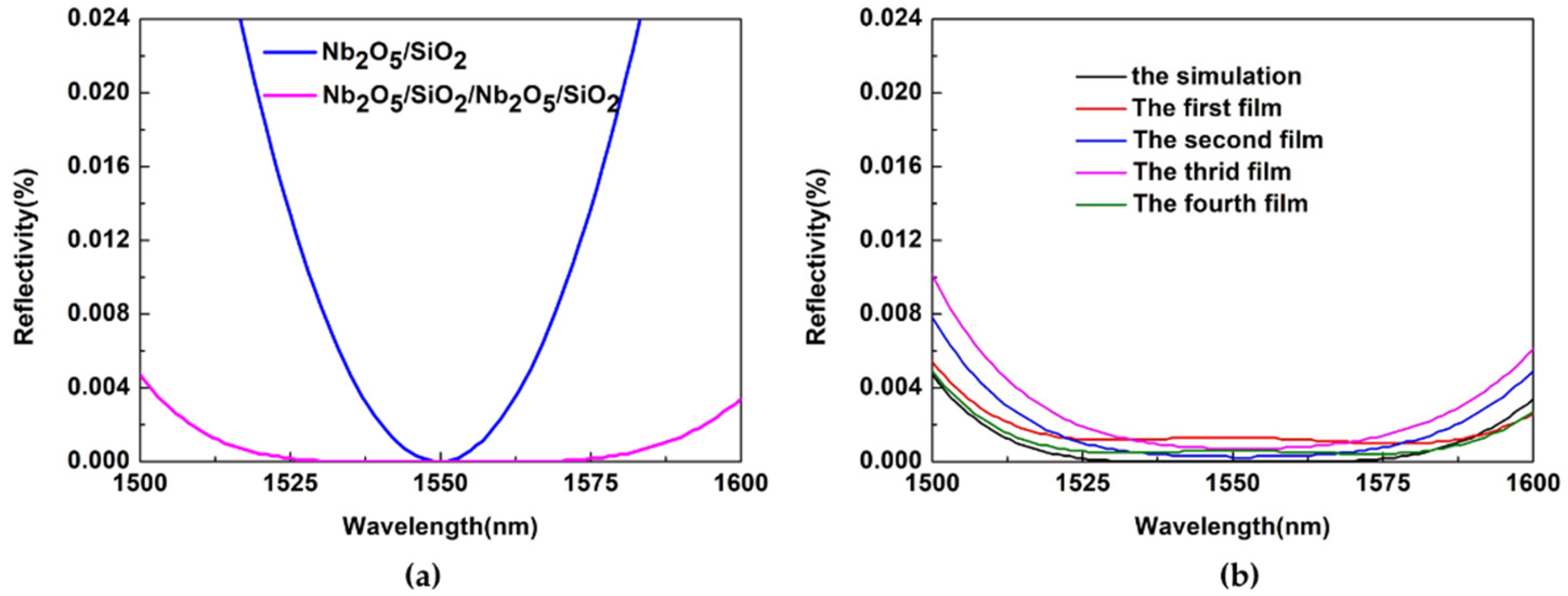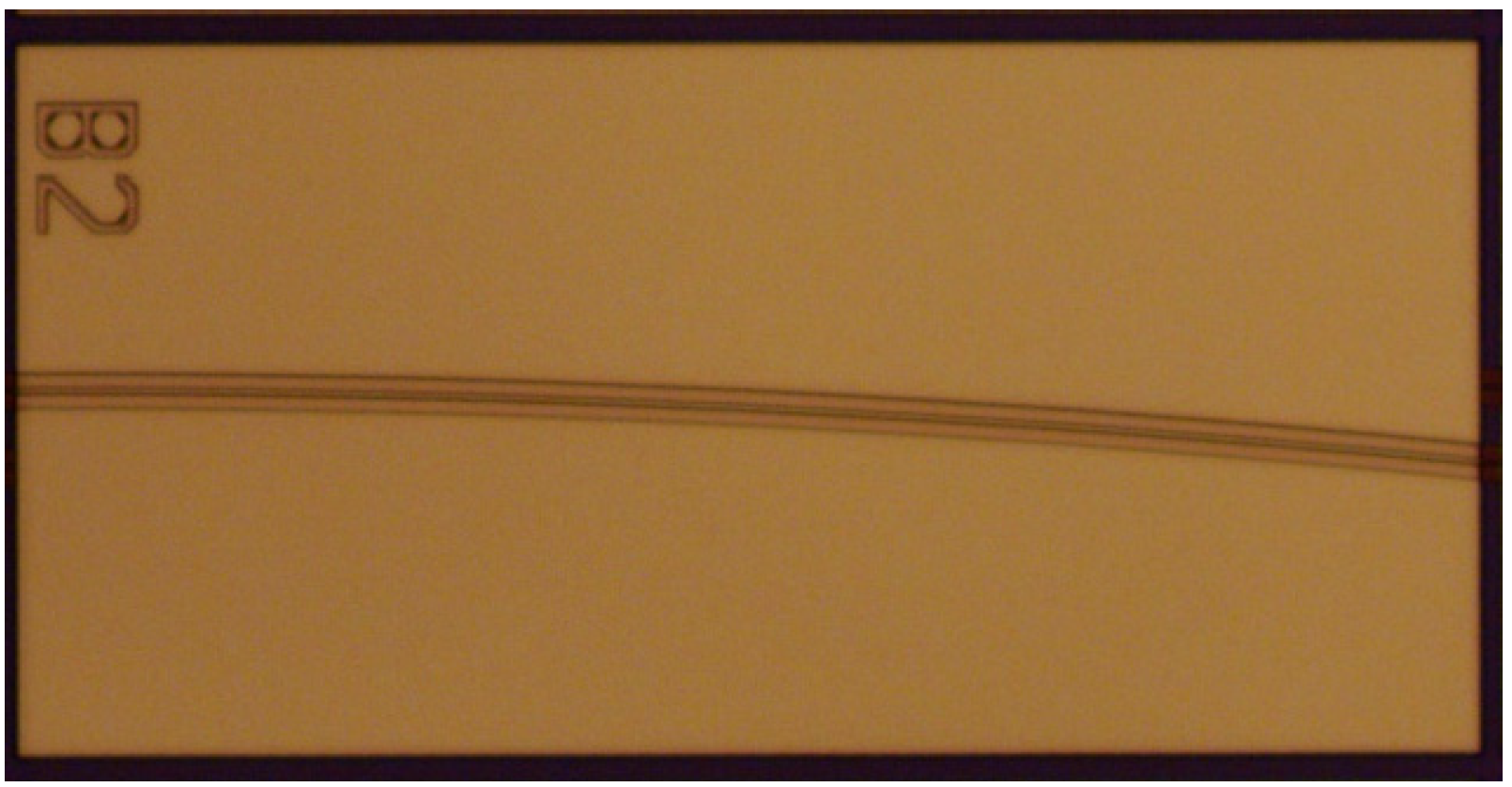Reflective Semiconductor Optical Amplifier Chip with Low Ripple for C-Band External Cavity Narrow-Linewidth Laser
Abstract
:1. Introduction
2. Design and Fabrication
2.1. Wide-Spectrum, Low-Reflectance Coating Design
2.2. Fabrication of the RSOA
3. Results and Discussion
3.1. Analysis of the Test Results of the Wideband Low-Reflectance Coating
3.2. Analysis of Light–Current (L-I), Voltage–Current (V-I), and Spectral Test Results
3.3. Analysis of Narrow-Linewidth Laser Test Results
4. Conclusions
Author Contributions
Funding
Institutional Review Board Statement
Informed Consent Statement
Data Availability Statement
Acknowledgments
Conflicts of Interest
References
- Seimetz, M. Laser linewidth limitations for optical systems with high-order modulation employing feed-forward digital carrier phase estimation. In Proceedings of the OFC/NFOEC 2008, San Diego, CA, USA, 24–28 February 2008. [Google Scholar]
- Tang, L.; Jia, H. Hybrid integrated low-noise linear chirp frequency-modulated continuous-wave laser source based on self-injection to an external cavity. Photonics Res. 2021, 9, 1948–1957. [Google Scholar] [CrossRef]
- Labaziewicz, J.; Richerme, P. Compact, filtered diode laser system for precision spectroscopy. Opt. Lett. 2007, 32, 572–574. [Google Scholar] [CrossRef] [PubMed]
- Gravel, B. Evaluation of a compact high power pulsed fiber laser source for laser-induced breakdown spectroscopy. J. Anal. At. Spectrom. 2011, 26, 1354–1361. [Google Scholar] [CrossRef]
- Wright, M.W.; Franzen, D. Qualification and reliability testing of a commercial high-power fiber-coupled semiconductor laser for space applications. Opt. Eng. 2005, 44, 054204. [Google Scholar] [CrossRef]
- Seimetz, M.; Molle, L. Coherent RZ-8PSK transmission at 30 Gbit/s over 1200 km employing homodyne detection with digital carrier phase estimation. In Proceedings of the 33rd European Conference and Exhibition of Optical Communication, Berlin, Germany, 16–20 September 2007. [Google Scholar]
- Schawlow, A.L.; Townes, C.H. Infrared and Optical Masers. Phys. Rev. 1958, 112, 1940–1949. [Google Scholar] [CrossRef]
- Henry, C. Theory of the linewidth of semiconductor lasers. I IEEE J. Quantum Electron. 1982, 18, 259–264. [Google Scholar] [CrossRef]
- Zediker, M.S.; Boucart, J. Eye safe high power laser diode in the 1410–1550 nm range. In Proceedings of the High-Power Diode Laser Technology and Applications VIII, San Francisco, CA, USA, 25–26 February 2010. [Google Scholar]
- Emmanuel, J.C.; Eldar, Y.C. Compressed Sensing with Coherent and Redundant Dictionaries. Appl. Comput. Harmon. Anal. 2011, 31, 59–73. [Google Scholar]
- Lang, R.; Kobayashi, K. External optical feedback effects on semiconductor injection laser properties. IEEE J. Quantum Electron. 1980, 16, 347–355. [Google Scholar] [CrossRef]
- Hoppe, M.; Rohling, H. New wide tunable external cavity interband cascade laser based on a micro-electro-mechanical system device. In Proceedings of the MOEMS and Miniaturized Systems XVIII, San Francisco, CA, USA, 2–4 March 2019. [Google Scholar]
- Hou, L.; Haji, M. Narrow linewidth laterally coupled 1.55 µm AlGaInAs/InP distributed feedback lasers integrated with a curved tapered semiconductor optical amplifier. Opt. Lett. 2012, 37, 4525–4527. [Google Scholar] [CrossRef]
- Wang, Z.; Shang, J. All-Polarization Maintaining Single-Longitudinal-Mode Fiber Laser with Ultra-High OSNR, Sub-kHz Linewidth and Extremely High Stability. Opt. Laser Technol. 2021, 141, 107135. [Google Scholar] [CrossRef]
- Liu, Y.; Zhang, M. Single-Longitudinal-Mode Triple-Ring Brillouin Fiber Laser with a Saturable Absorber Ring Resonator. J. Light. Technol. 2017, 35, 1744–1749. [Google Scholar] [CrossRef]
- Voo, N.Y.; Horak, P. Anomalous linewidth behavior in short-cavity single-frequency fiber lasers. IEEE Photonics Technol. Lett. 2005, 17, 546–548. [Google Scholar] [CrossRef]
- Guo, Y.; Li, X. Hybrid integrated external cavity laser with a 172-nm tuning range. APL Photonics 2022, 7, 066101. [Google Scholar] [CrossRef]
- Riehle, F. Frequency Standards: Basics and Applications; John Wiley & Sons, Inc.: Hoboken, NJ, USA, 2006. [Google Scholar]
- Kim, H.S.; Choi, B.S. Improvement of modulation bandwidth in multisection RSOA for colorless WDM-PON. Opt. Express 2009, 17, 16372–16378. [Google Scholar] [CrossRef] [PubMed]
- Parolari, P. 10-Gb/s Operation of a Colorless Self-Seeded Transmitter Over More Than 70 km of SSMF. IEEE Photonics Technol. Lett. 2014, 26, 599–602. [Google Scholar] [CrossRef]
- Parolari, P.; Marazzi, L. C- and O-Band Operation of RSOA WDM PON Self-Seeded Transmitters up to 10 Gb/s. J. Opt. Commun. Netw. 2015, 7, A249–A255. [Google Scholar] [CrossRef]
- Taebi, S.; Saini, S.S. L-Band Polarization-Independent Reflective SOA for WDM-PON Applications. IEEE Photonics Technol. Lett. 2009, 21, 334–336. [Google Scholar] [CrossRef]
- Kelly, A.E. High performance polarisation independent reflective semiconductor optical amplifiers in the S, C, and L bands. IEEE J. Sel. Areas Commun. 2010, 28, 943–948. [Google Scholar] [CrossRef]
- Valicourt, G.d.; Maho, A. Novel bidirectional reflective semiconductor optical amplifier. In Proceedings of the 2016 21st OptoElectronics and Communications Conference, Niigata, Japan, 3–7 July 2016. [Google Scholar]
- Valicourt, G.d. Radio-Over-Fiber Access Network Architecture Based on New Optimized RSOA Devices With Large Modulation Bandwidth and High Linearity. IEEE Trans. Microw. Theory Tech. 2010, 58, 3248–3258. [Google Scholar] [CrossRef]
- Alphonse, G.A. Design of high-power super luminescent diodes with low spectral modulation. In Proceedings of the SPIE 2002, San Jose, CA, USA, 19–25 January 2002. [Google Scholar]
- Ghafouri-Shiraz, H. Analysis of facet reflectivity, mirror loss, single-transverse mode condition and beam divergence angle at 1.3 pm and 1.55 pm wavelength of InGaAsP/InP buried heterostructure semiconductor laser diodes. Opt. Laser Technol. 1990, 22, 38–46. [Google Scholar] [CrossRef]
- Jaskorzynska, B.; Nilsson, M.J. reflectivity of uptapered, tilted-facet, and antireflection-coated di-ode-laser amplifiers. J. Opt. Soc. Am. B 1991, 8, 484–493. [Google Scholar] [CrossRef]
- Rani, R.A.; Zoolfakar, A. Thin films and nanostructures of niobium pentoxide: Fundamental properties, synthesis methods and applications. J. Mater. Chem. A 2014, 2, 15683–15703. [Google Scholar] [CrossRef]
- Nico, C.; Monteiro, T. Niobium oxides and niobates physical properties: Review and prospects. Prog. Mater. Sci. 2016, 80, 1–37. [Google Scholar] [CrossRef]
- Chen, K.N.; Hsu, C.M. Investigation of antireflection Nb2O5 thin films by the sputtering method under different deposition parameters. Micromachines 2016, 7, 151. [Google Scholar] [CrossRef] [PubMed]
- Horprathum, M.; Eiamchai, P. Structural, optical and hydrophilic properties of nanocrystalline TiO2 ultra-thin films prepared by pulsed dc reactive magnetron sputtering. J. Alloys Compd. 2011, 509, 4520–4524. [Google Scholar] [CrossRef]
- Tian, G.; He, H. Effect of microstructure of TiO2 thin films on optical band gap energy. Chin. Phys. Lett. 2005, 22, 1787–1789. [Google Scholar]
- Wang, W.-H.; Chao, S. Annealing effect on ion- beam—Sputtered titanium dioxide film. Opt. Lett. 1998, 23, 1417–1419. [Google Scholar] [CrossRef]
- Zhao, Z.; Tay, B.K. Room-temperature deposition of amorphous titanium dioxide thin film with high refractive index by a filtered cathodic vacuum arc technique. Appl. Opt. 2004, 43, 1281–1285. [Google Scholar] [CrossRef]
- Asanuma, T.; Matsutani, T. Structural and optical properties of titanium dioxide films deposited by reactive magnetron sputtering in pure oxygen plasma. J. Appl. Phys. 2004, 95, 6011–6016. [Google Scholar] [CrossRef]
- Sun, L.; Hou, P. Spectroscopic ellipsometry study one-beam deposited titanium dioxide films. Thin Solid Films 2004, 455–456, 525–529. [Google Scholar] [CrossRef]
- Bennett, J.M.; Pelletier, E. Comparison of the properties of titanium dioxide films prepared by various technique. Appl. Opt. 1989, 28, 3303–3317. [Google Scholar] [CrossRef] [PubMed]
- Venkataraj, S.; Drese, R. Temperature stability of sputtered niobium—Oxide films. J. Appl. Phys. 2002, 91, 4863–4871. [Google Scholar] [CrossRef]
- Lee, C.; Tien, C. Internal stress and optical properties of Nb2O5 thin films deposited by ion—Beam sputtering. Appl. Opt. 2002, 41, 2043–2047. [Google Scholar] [CrossRef]
- Lai, F.; Li, M. Optical scattering characteristic of annealed niobium oxide films. Thin Solid Film. 2005, 488, 314–320. [Google Scholar] [CrossRef]
- Hellmich, W.; Deimel, P.P. Optimal AR-coating for optical waveguide devices. J. Light. Technol. 1992, 10, 469–476. [Google Scholar] [CrossRef]
- Kendall, P.C.; Roberts, D.A. Semiconductor laser facet reflectivities using free-space radiation modes. IEEE Proc. J. Optoelectron. 1993, 1, 49–55. [Google Scholar] [CrossRef]
- Saitoh, T.; Mukai, T. Theoretical analysis and fabrication of antireflection coatings on laser-diode facets. J. Light. Technol. 1985, 3, 288–293. [Google Scholar] [CrossRef]
- Vassallo, C. Theory and practical calculation of antireflection coatings on semiconductor laser diode optical amplifiers. IEEE Proc. J. Optoelectron. 1990, 137, 193–202. [Google Scholar] [CrossRef]
- Born, M.; Wolf, E. Wave Propagation in a Stratified Medium: Theory of Dielectric Films, Principles of Optics, 7th ed.; Cambridge University Press: Cambridge, UK, 1999. [Google Scholar]
- Vizbaras, K.; Dvinelis, E. High power continuous-wave GaSb-based super luminescent diodes as gain chips for widely tunable laser spectroscopy in the 1.95–2.45 μm wavelength range. Appl. Phys. Lett. 2015, 107, 011103. [Google Scholar] [CrossRef]
- Heim, P.J.S.; Fan, Z.F. Single-angled-facet laser diode for widely tunable external cavity semiconductor lasers with high spectral purity. Electron. Lett. 1997, 33, 1387–1389. [Google Scholar] [CrossRef]
- Gianni, D.D.; Stéphane, S. Simple approach to the relation between laser frequency noise and laser line shape. Appl. Opt. 2010, 49, 4801–4807. [Google Scholar]










Disclaimer/Publisher’s Note: The statements, opinions and data contained in all publications are solely those of the individual author(s) and contributor(s) and not of MDPI and/or the editor(s). MDPI and/or the editor(s) disclaim responsibility for any injury to people or property resulting from any ideas, methods, instructions or products referred to in the content. |
© 2025 by the authors. Licensee MDPI, Basel, Switzerland. This article is an open access article distributed under the terms and conditions of the Creative Commons Attribution (CC BY) license (https://creativecommons.org/licenses/by/4.0/).
Share and Cite
Li, S.; Yu, H.; Bao, H.; Ren, M.; Liu, J.; Liu, Z.; Cao, Y. Reflective Semiconductor Optical Amplifier Chip with Low Ripple for C-Band External Cavity Narrow-Linewidth Laser. Photonics 2025, 12, 193. https://doi.org/10.3390/photonics12030193
Li S, Yu H, Bao H, Ren M, Liu J, Liu Z, Cao Y. Reflective Semiconductor Optical Amplifier Chip with Low Ripple for C-Band External Cavity Narrow-Linewidth Laser. Photonics. 2025; 12(3):193. https://doi.org/10.3390/photonics12030193
Chicago/Turabian StyleLi, Shaojie, Haiyang Yu, Haotian Bao, Menghan Ren, Jianguo Liu, Zeqiu Liu, and Yulian Cao. 2025. "Reflective Semiconductor Optical Amplifier Chip with Low Ripple for C-Band External Cavity Narrow-Linewidth Laser" Photonics 12, no. 3: 193. https://doi.org/10.3390/photonics12030193
APA StyleLi, S., Yu, H., Bao, H., Ren, M., Liu, J., Liu, Z., & Cao, Y. (2025). Reflective Semiconductor Optical Amplifier Chip with Low Ripple for C-Band External Cavity Narrow-Linewidth Laser. Photonics, 12(3), 193. https://doi.org/10.3390/photonics12030193




